Decision Making & Problem Solving Report: Zumbo Patisserie Case Study
VerifiedAdded on 2020/04/01
|14
|2403
|61
Report
AI Summary
This report analyzes employee disputes and decision-making processes at the Australian patisserie company, Zumbo. The study investigates the relationship between job satisfaction and employee retention, identifying payment-related issues as the primary source of conflict. Data was collected from a sample of 30 employees using questionnaires, employing both qualitative and quantitative research methods. Descriptive analysis reveals gender and age distribution, length of service, and job satisfaction levels. Regression analysis indicates that job satisfaction does not significantly predict employee retention, while payment discrepancies, including unpaid superannuation and overtime, are major sources of contention. The report concludes by discussing factors influencing employee retention, such as skill retention, work environment, and job flexibility, highlighting the need for Zumbo to address financial and workplace concerns to improve employee retention and resolve disputes.
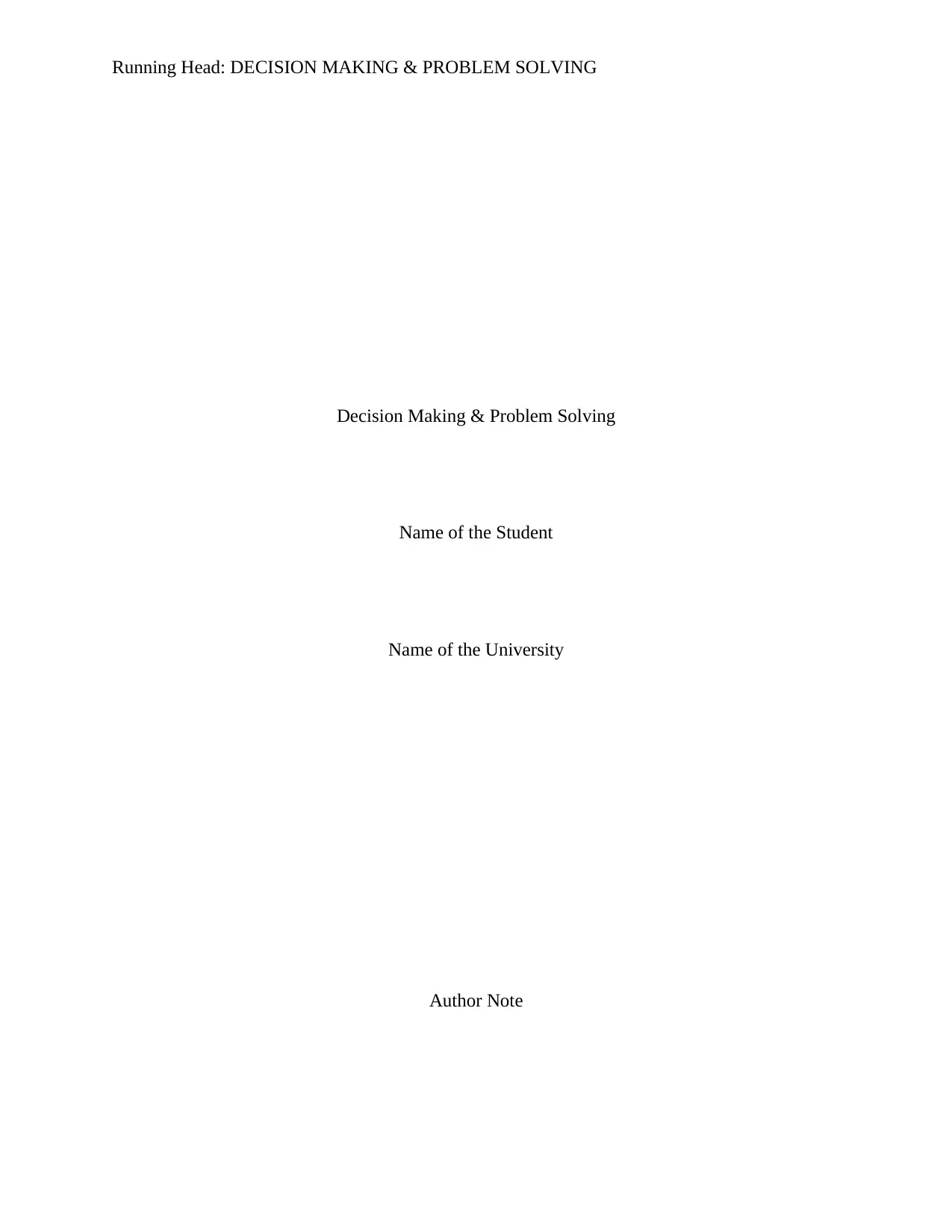
Running Head: DECISION MAKING & PROBLEM SOLVING
Decision Making & Problem Solving
Name of the Student
Name of the University
Author Note
Decision Making & Problem Solving
Name of the Student
Name of the University
Author Note
Paraphrase This Document
Need a fresh take? Get an instant paraphrase of this document with our AI Paraphraser
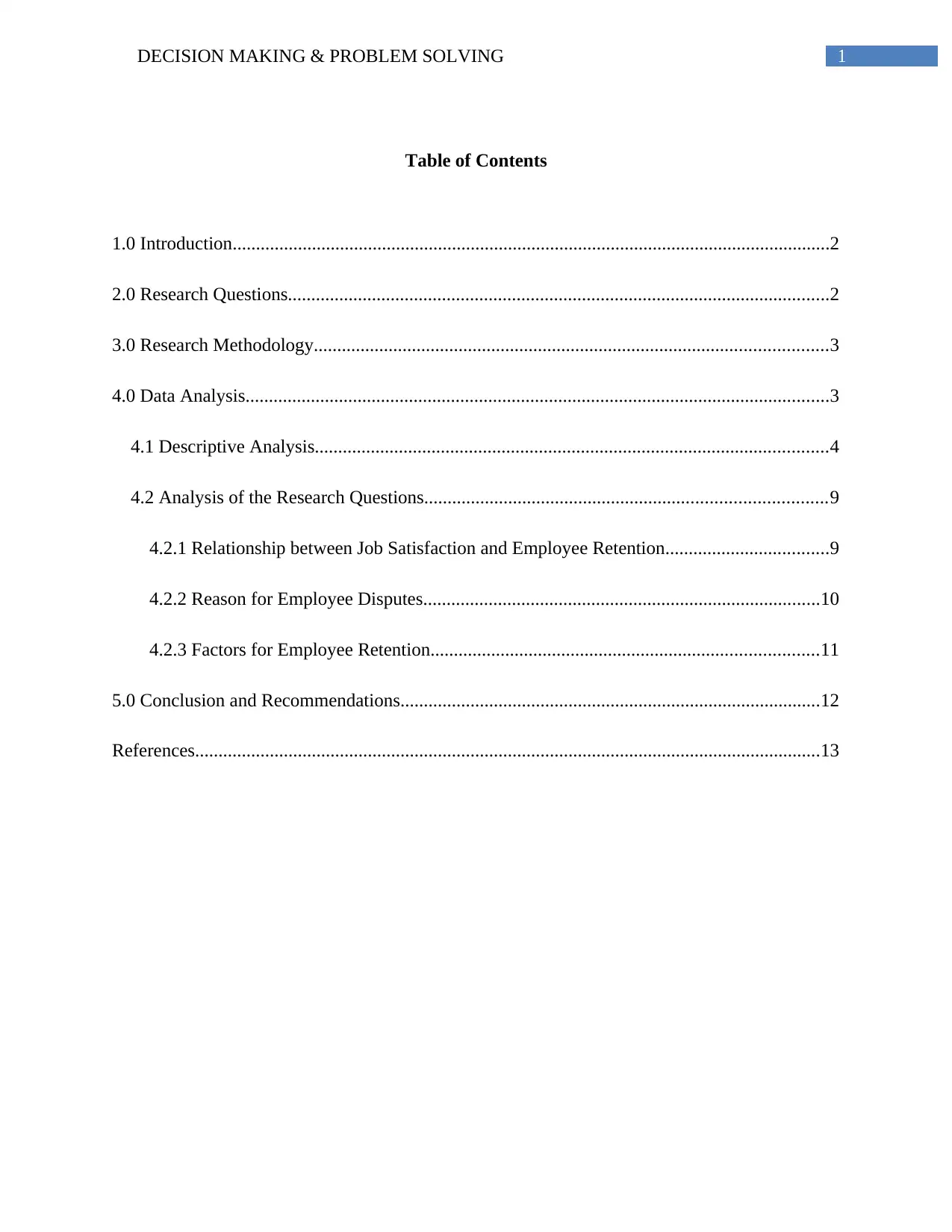
1DECISION MAKING & PROBLEM SOLVING
Table of Contents
1.0 Introduction................................................................................................................................2
2.0 Research Questions....................................................................................................................2
3.0 Research Methodology..............................................................................................................3
4.0 Data Analysis.............................................................................................................................3
4.1 Descriptive Analysis..............................................................................................................4
4.2 Analysis of the Research Questions......................................................................................9
4.2.1 Relationship between Job Satisfaction and Employee Retention...................................9
4.2.2 Reason for Employee Disputes.....................................................................................10
4.2.3 Factors for Employee Retention...................................................................................11
5.0 Conclusion and Recommendations..........................................................................................12
References......................................................................................................................................13
Table of Contents
1.0 Introduction................................................................................................................................2
2.0 Research Questions....................................................................................................................2
3.0 Research Methodology..............................................................................................................3
4.0 Data Analysis.............................................................................................................................3
4.1 Descriptive Analysis..............................................................................................................4
4.2 Analysis of the Research Questions......................................................................................9
4.2.1 Relationship between Job Satisfaction and Employee Retention...................................9
4.2.2 Reason for Employee Disputes.....................................................................................10
4.2.3 Factors for Employee Retention...................................................................................11
5.0 Conclusion and Recommendations..........................................................................................12
References......................................................................................................................................13
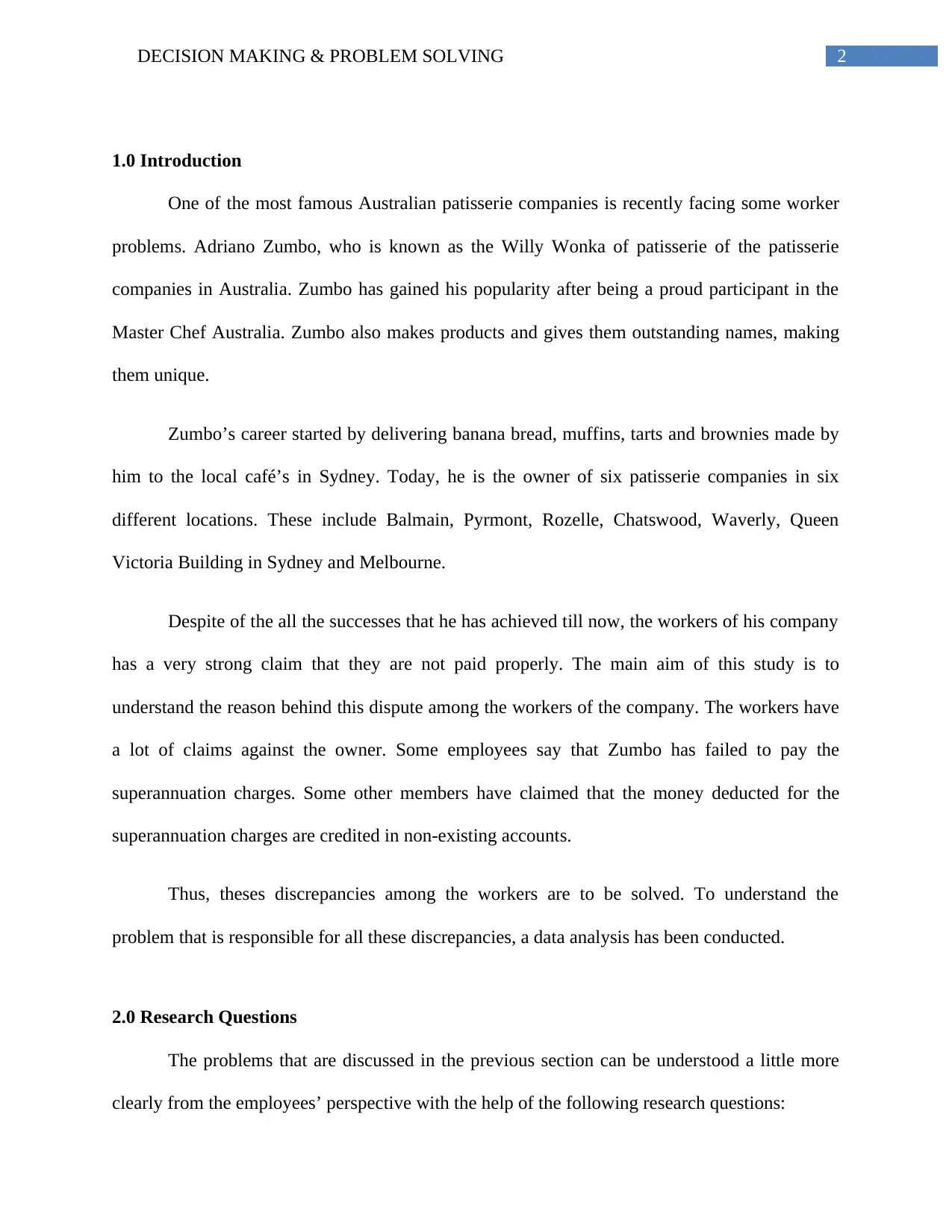
2DECISION MAKING & PROBLEM SOLVING
1.0 Introduction
One of the most famous Australian patisserie companies is recently facing some worker
problems. Adriano Zumbo, who is known as the Willy Wonka of patisserie of the patisserie
companies in Australia. Zumbo has gained his popularity after being a proud participant in the
Master Chef Australia. Zumbo also makes products and gives them outstanding names, making
them unique.
Zumbo’s career started by delivering banana bread, muffins, tarts and brownies made by
him to the local café’s in Sydney. Today, he is the owner of six patisserie companies in six
different locations. These include Balmain, Pyrmont, Rozelle, Chatswood, Waverly, Queen
Victoria Building in Sydney and Melbourne.
Despite of the all the successes that he has achieved till now, the workers of his company
has a very strong claim that they are not paid properly. The main aim of this study is to
understand the reason behind this dispute among the workers of the company. The workers have
a lot of claims against the owner. Some employees say that Zumbo has failed to pay the
superannuation charges. Some other members have claimed that the money deducted for the
superannuation charges are credited in non-existing accounts.
Thus, theses discrepancies among the workers are to be solved. To understand the
problem that is responsible for all these discrepancies, a data analysis has been conducted.
2.0 Research Questions
The problems that are discussed in the previous section can be understood a little more
clearly from the employees’ perspective with the help of the following research questions:
1.0 Introduction
One of the most famous Australian patisserie companies is recently facing some worker
problems. Adriano Zumbo, who is known as the Willy Wonka of patisserie of the patisserie
companies in Australia. Zumbo has gained his popularity after being a proud participant in the
Master Chef Australia. Zumbo also makes products and gives them outstanding names, making
them unique.
Zumbo’s career started by delivering banana bread, muffins, tarts and brownies made by
him to the local café’s in Sydney. Today, he is the owner of six patisserie companies in six
different locations. These include Balmain, Pyrmont, Rozelle, Chatswood, Waverly, Queen
Victoria Building in Sydney and Melbourne.
Despite of the all the successes that he has achieved till now, the workers of his company
has a very strong claim that they are not paid properly. The main aim of this study is to
understand the reason behind this dispute among the workers of the company. The workers have
a lot of claims against the owner. Some employees say that Zumbo has failed to pay the
superannuation charges. Some other members have claimed that the money deducted for the
superannuation charges are credited in non-existing accounts.
Thus, theses discrepancies among the workers are to be solved. To understand the
problem that is responsible for all these discrepancies, a data analysis has been conducted.
2.0 Research Questions
The problems that are discussed in the previous section can be understood a little more
clearly from the employees’ perspective with the help of the following research questions:
⊘ This is a preview!⊘
Do you want full access?
Subscribe today to unlock all pages.

Trusted by 1+ million students worldwide
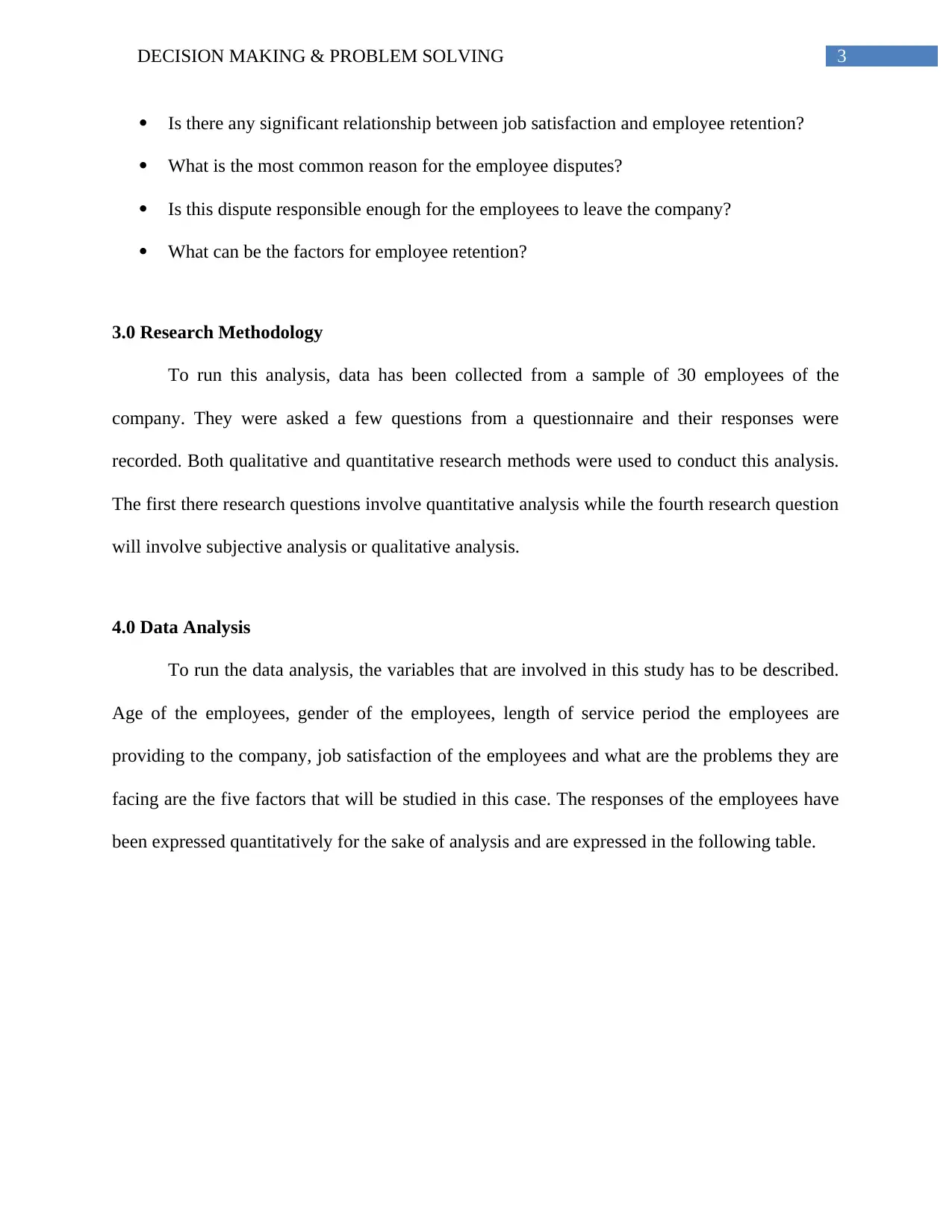
3DECISION MAKING & PROBLEM SOLVING
Is there any significant relationship between job satisfaction and employee retention?
What is the most common reason for the employee disputes?
Is this dispute responsible enough for the employees to leave the company?
What can be the factors for employee retention?
3.0 Research Methodology
To run this analysis, data has been collected from a sample of 30 employees of the
company. They were asked a few questions from a questionnaire and their responses were
recorded. Both qualitative and quantitative research methods were used to conduct this analysis.
The first there research questions involve quantitative analysis while the fourth research question
will involve subjective analysis or qualitative analysis.
4.0 Data Analysis
To run the data analysis, the variables that are involved in this study has to be described.
Age of the employees, gender of the employees, length of service period the employees are
providing to the company, job satisfaction of the employees and what are the problems they are
facing are the five factors that will be studied in this case. The responses of the employees have
been expressed quantitatively for the sake of analysis and are expressed in the following table.
Is there any significant relationship between job satisfaction and employee retention?
What is the most common reason for the employee disputes?
Is this dispute responsible enough for the employees to leave the company?
What can be the factors for employee retention?
3.0 Research Methodology
To run this analysis, data has been collected from a sample of 30 employees of the
company. They were asked a few questions from a questionnaire and their responses were
recorded. Both qualitative and quantitative research methods were used to conduct this analysis.
The first there research questions involve quantitative analysis while the fourth research question
will involve subjective analysis or qualitative analysis.
4.0 Data Analysis
To run the data analysis, the variables that are involved in this study has to be described.
Age of the employees, gender of the employees, length of service period the employees are
providing to the company, job satisfaction of the employees and what are the problems they are
facing are the five factors that will be studied in this case. The responses of the employees have
been expressed quantitatively for the sake of analysis and are expressed in the following table.
Paraphrase This Document
Need a fresh take? Get an instant paraphrase of this document with our AI Paraphraser
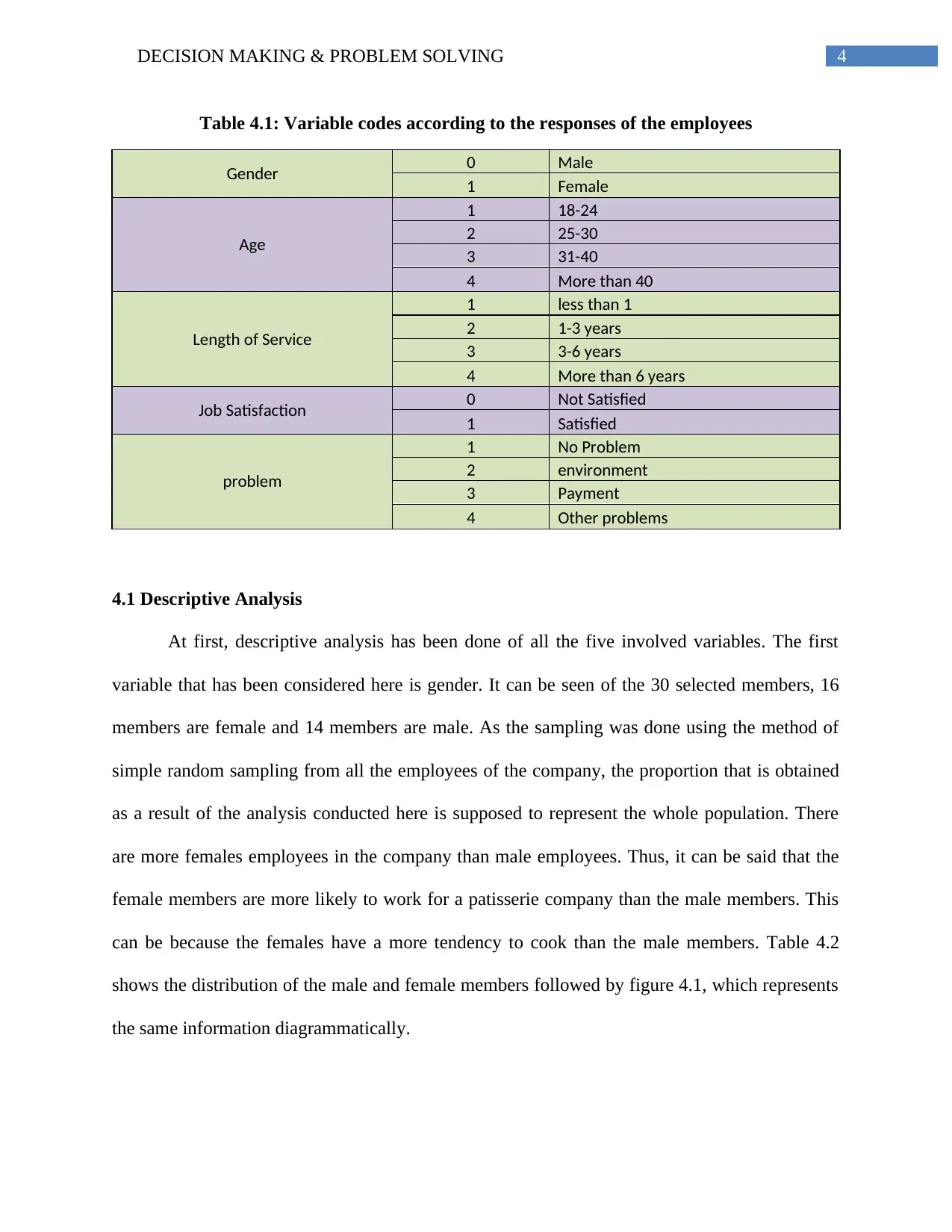
4DECISION MAKING & PROBLEM SOLVING
Table 4.1: Variable codes according to the responses of the employees
Gender 0 Male
1 Female
Age
1 18-24
2 25-30
3 31-40
4 More than 40
Length of Service
1 less than 1
2 1-3 years
3 3-6 years
4 More than 6 years
Job Satisfaction 0 Not Satisfied
1 Satisfied
problem
1 No Problem
2 environment
3 Payment
4 Other problems
4.1 Descriptive Analysis
At first, descriptive analysis has been done of all the five involved variables. The first
variable that has been considered here is gender. It can be seen of the 30 selected members, 16
members are female and 14 members are male. As the sampling was done using the method of
simple random sampling from all the employees of the company, the proportion that is obtained
as a result of the analysis conducted here is supposed to represent the whole population. There
are more females employees in the company than male employees. Thus, it can be said that the
female members are more likely to work for a patisserie company than the male members. This
can be because the females have a more tendency to cook than the male members. Table 4.2
shows the distribution of the male and female members followed by figure 4.1, which represents
the same information diagrammatically.
Table 4.1: Variable codes according to the responses of the employees
Gender 0 Male
1 Female
Age
1 18-24
2 25-30
3 31-40
4 More than 40
Length of Service
1 less than 1
2 1-3 years
3 3-6 years
4 More than 6 years
Job Satisfaction 0 Not Satisfied
1 Satisfied
problem
1 No Problem
2 environment
3 Payment
4 Other problems
4.1 Descriptive Analysis
At first, descriptive analysis has been done of all the five involved variables. The first
variable that has been considered here is gender. It can be seen of the 30 selected members, 16
members are female and 14 members are male. As the sampling was done using the method of
simple random sampling from all the employees of the company, the proportion that is obtained
as a result of the analysis conducted here is supposed to represent the whole population. There
are more females employees in the company than male employees. Thus, it can be said that the
female members are more likely to work for a patisserie company than the male members. This
can be because the females have a more tendency to cook than the male members. Table 4.2
shows the distribution of the male and female members followed by figure 4.1, which represents
the same information diagrammatically.
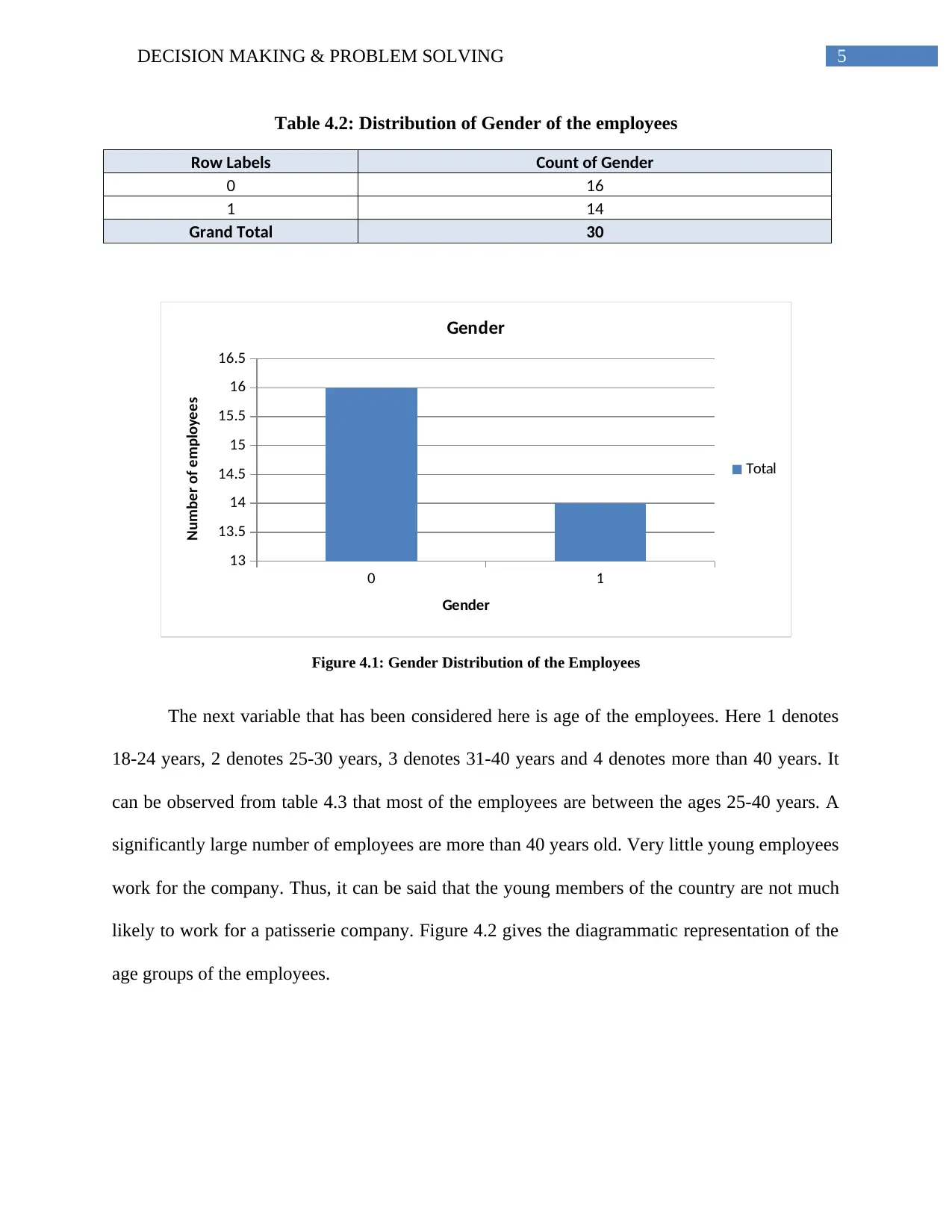
5DECISION MAKING & PROBLEM SOLVING
Table 4.2: Distribution of Gender of the employees
Row Labels Count of Gender
0 16
1 14
Grand Total 30
0 1
13
13.5
14
14.5
15
15.5
16
16.5
Gender
Total
Gender
Number of employees
Figure 4.1: Gender Distribution of the Employees
The next variable that has been considered here is age of the employees. Here 1 denotes
18-24 years, 2 denotes 25-30 years, 3 denotes 31-40 years and 4 denotes more than 40 years. It
can be observed from table 4.3 that most of the employees are between the ages 25-40 years. A
significantly large number of employees are more than 40 years old. Very little young employees
work for the company. Thus, it can be said that the young members of the country are not much
likely to work for a patisserie company. Figure 4.2 gives the diagrammatic representation of the
age groups of the employees.
Table 4.2: Distribution of Gender of the employees
Row Labels Count of Gender
0 16
1 14
Grand Total 30
0 1
13
13.5
14
14.5
15
15.5
16
16.5
Gender
Total
Gender
Number of employees
Figure 4.1: Gender Distribution of the Employees
The next variable that has been considered here is age of the employees. Here 1 denotes
18-24 years, 2 denotes 25-30 years, 3 denotes 31-40 years and 4 denotes more than 40 years. It
can be observed from table 4.3 that most of the employees are between the ages 25-40 years. A
significantly large number of employees are more than 40 years old. Very little young employees
work for the company. Thus, it can be said that the young members of the country are not much
likely to work for a patisserie company. Figure 4.2 gives the diagrammatic representation of the
age groups of the employees.
⊘ This is a preview!⊘
Do you want full access?
Subscribe today to unlock all pages.

Trusted by 1+ million students worldwide
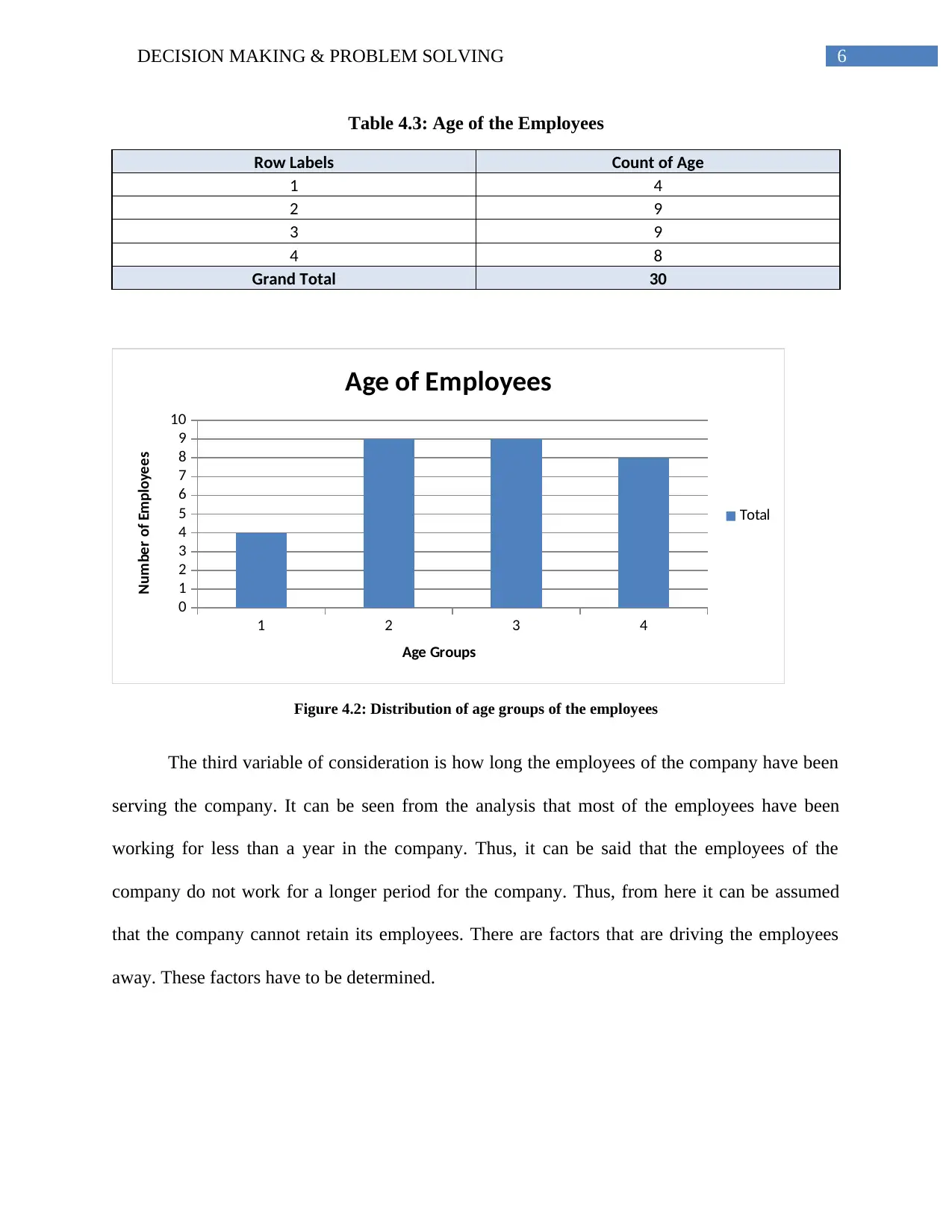
6DECISION MAKING & PROBLEM SOLVING
Table 4.3: Age of the Employees
Row Labels Count of Age
1 4
2 9
3 9
4 8
Grand Total 30
1 2 3 4
0
1
2
3
4
5
6
7
8
9
10
Age of Employees
Total
Age Groups
Number of Employees
Figure 4.2: Distribution of age groups of the employees
The third variable of consideration is how long the employees of the company have been
serving the company. It can be seen from the analysis that most of the employees have been
working for less than a year in the company. Thus, it can be said that the employees of the
company do not work for a longer period for the company. Thus, from here it can be assumed
that the company cannot retain its employees. There are factors that are driving the employees
away. These factors have to be determined.
Table 4.3: Age of the Employees
Row Labels Count of Age
1 4
2 9
3 9
4 8
Grand Total 30
1 2 3 4
0
1
2
3
4
5
6
7
8
9
10
Age of Employees
Total
Age Groups
Number of Employees
Figure 4.2: Distribution of age groups of the employees
The third variable of consideration is how long the employees of the company have been
serving the company. It can be seen from the analysis that most of the employees have been
working for less than a year in the company. Thus, it can be said that the employees of the
company do not work for a longer period for the company. Thus, from here it can be assumed
that the company cannot retain its employees. There are factors that are driving the employees
away. These factors have to be determined.
Paraphrase This Document
Need a fresh take? Get an instant paraphrase of this document with our AI Paraphraser
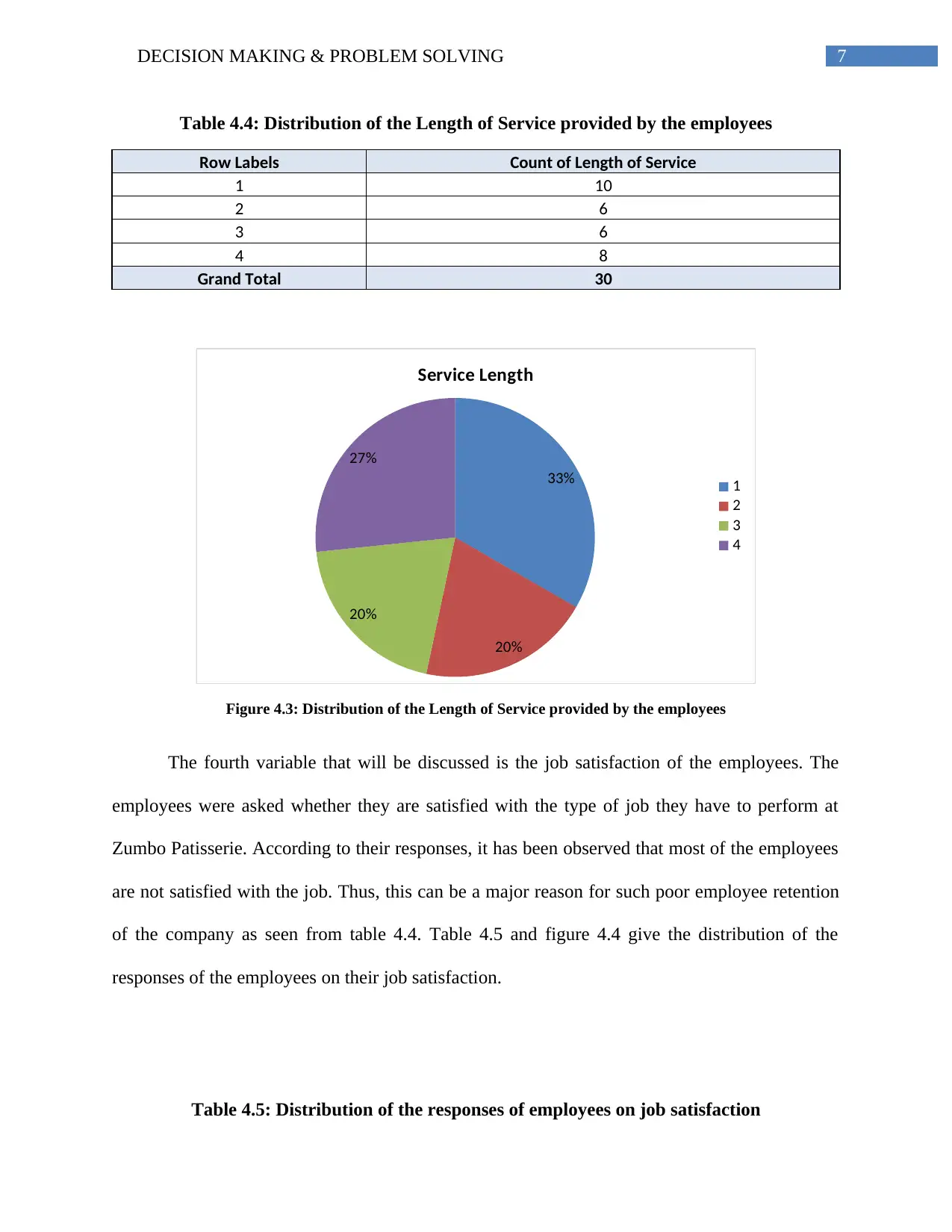
7DECISION MAKING & PROBLEM SOLVING
Table 4.4: Distribution of the Length of Service provided by the employees
Row Labels Count of Length of Service
1 10
2 6
3 6
4 8
Grand Total 30
33%
20%
20%
27%
Service Length
1
2
3
4
Figure 4.3: Distribution of the Length of Service provided by the employees
The fourth variable that will be discussed is the job satisfaction of the employees. The
employees were asked whether they are satisfied with the type of job they have to perform at
Zumbo Patisserie. According to their responses, it has been observed that most of the employees
are not satisfied with the job. Thus, this can be a major reason for such poor employee retention
of the company as seen from table 4.4. Table 4.5 and figure 4.4 give the distribution of the
responses of the employees on their job satisfaction.
Table 4.5: Distribution of the responses of employees on job satisfaction
Table 4.4: Distribution of the Length of Service provided by the employees
Row Labels Count of Length of Service
1 10
2 6
3 6
4 8
Grand Total 30
33%
20%
20%
27%
Service Length
1
2
3
4
Figure 4.3: Distribution of the Length of Service provided by the employees
The fourth variable that will be discussed is the job satisfaction of the employees. The
employees were asked whether they are satisfied with the type of job they have to perform at
Zumbo Patisserie. According to their responses, it has been observed that most of the employees
are not satisfied with the job. Thus, this can be a major reason for such poor employee retention
of the company as seen from table 4.4. Table 4.5 and figure 4.4 give the distribution of the
responses of the employees on their job satisfaction.
Table 4.5: Distribution of the responses of employees on job satisfaction
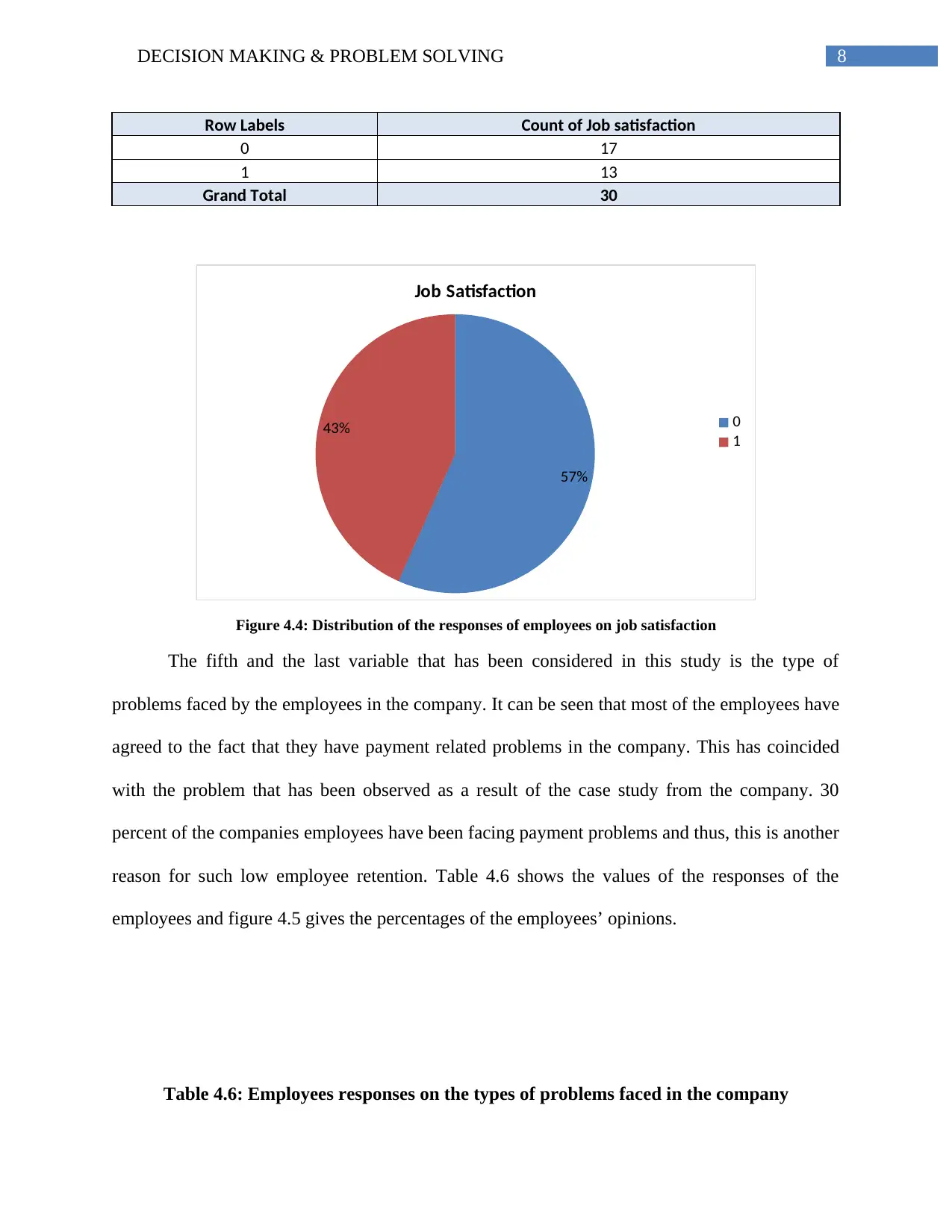
8DECISION MAKING & PROBLEM SOLVING
Row Labels Count of Job satisfaction
0 17
1 13
Grand Total 30
57%
43%
Job Satisfaction
0
1
Figure 4.4: Distribution of the responses of employees on job satisfaction
The fifth and the last variable that has been considered in this study is the type of
problems faced by the employees in the company. It can be seen that most of the employees have
agreed to the fact that they have payment related problems in the company. This has coincided
with the problem that has been observed as a result of the case study from the company. 30
percent of the companies employees have been facing payment problems and thus, this is another
reason for such low employee retention. Table 4.6 shows the values of the responses of the
employees and figure 4.5 gives the percentages of the employees’ opinions.
Table 4.6: Employees responses on the types of problems faced in the company
Row Labels Count of Job satisfaction
0 17
1 13
Grand Total 30
57%
43%
Job Satisfaction
0
1
Figure 4.4: Distribution of the responses of employees on job satisfaction
The fifth and the last variable that has been considered in this study is the type of
problems faced by the employees in the company. It can be seen that most of the employees have
agreed to the fact that they have payment related problems in the company. This has coincided
with the problem that has been observed as a result of the case study from the company. 30
percent of the companies employees have been facing payment problems and thus, this is another
reason for such low employee retention. Table 4.6 shows the values of the responses of the
employees and figure 4.5 gives the percentages of the employees’ opinions.
Table 4.6: Employees responses on the types of problems faced in the company
⊘ This is a preview!⊘
Do you want full access?
Subscribe today to unlock all pages.

Trusted by 1+ million students worldwide
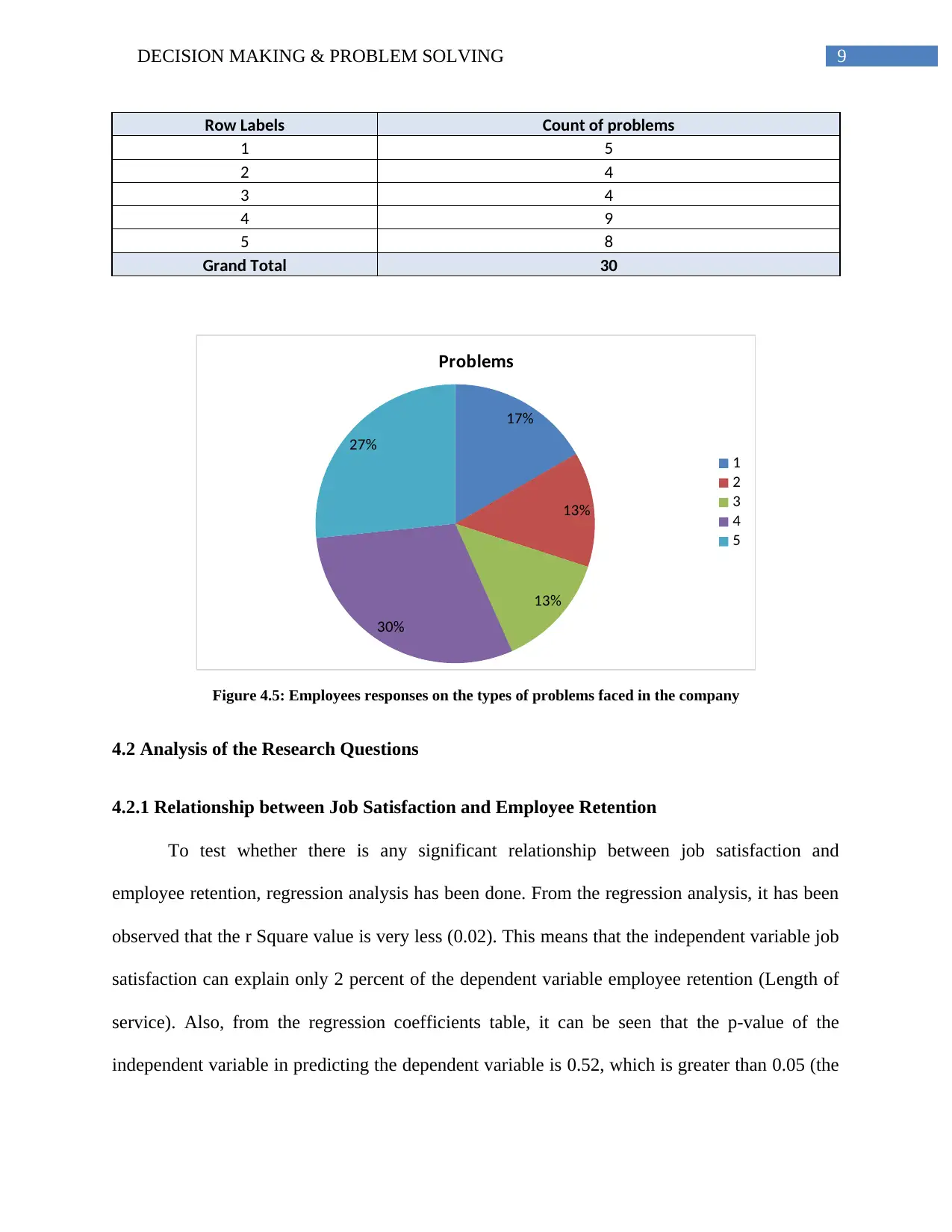
9DECISION MAKING & PROBLEM SOLVING
Row Labels Count of problems
1 5
2 4
3 4
4 9
5 8
Grand Total 30
17%
13%
13%
30%
27%
Problems
1
2
3
4
5
Figure 4.5: Employees responses on the types of problems faced in the company
4.2 Analysis of the Research Questions
4.2.1 Relationship between Job Satisfaction and Employee Retention
To test whether there is any significant relationship between job satisfaction and
employee retention, regression analysis has been done. From the regression analysis, it has been
observed that the r Square value is very less (0.02). This means that the independent variable job
satisfaction can explain only 2 percent of the dependent variable employee retention (Length of
service). Also, from the regression coefficients table, it can be seen that the p-value of the
independent variable in predicting the dependent variable is 0.52, which is greater than 0.05 (the
Row Labels Count of problems
1 5
2 4
3 4
4 9
5 8
Grand Total 30
17%
13%
13%
30%
27%
Problems
1
2
3
4
5
Figure 4.5: Employees responses on the types of problems faced in the company
4.2 Analysis of the Research Questions
4.2.1 Relationship between Job Satisfaction and Employee Retention
To test whether there is any significant relationship between job satisfaction and
employee retention, regression analysis has been done. From the regression analysis, it has been
observed that the r Square value is very less (0.02). This means that the independent variable job
satisfaction can explain only 2 percent of the dependent variable employee retention (Length of
service). Also, from the regression coefficients table, it can be seen that the p-value of the
independent variable in predicting the dependent variable is 0.52, which is greater than 0.05 (the
Paraphrase This Document
Need a fresh take? Get an instant paraphrase of this document with our AI Paraphraser
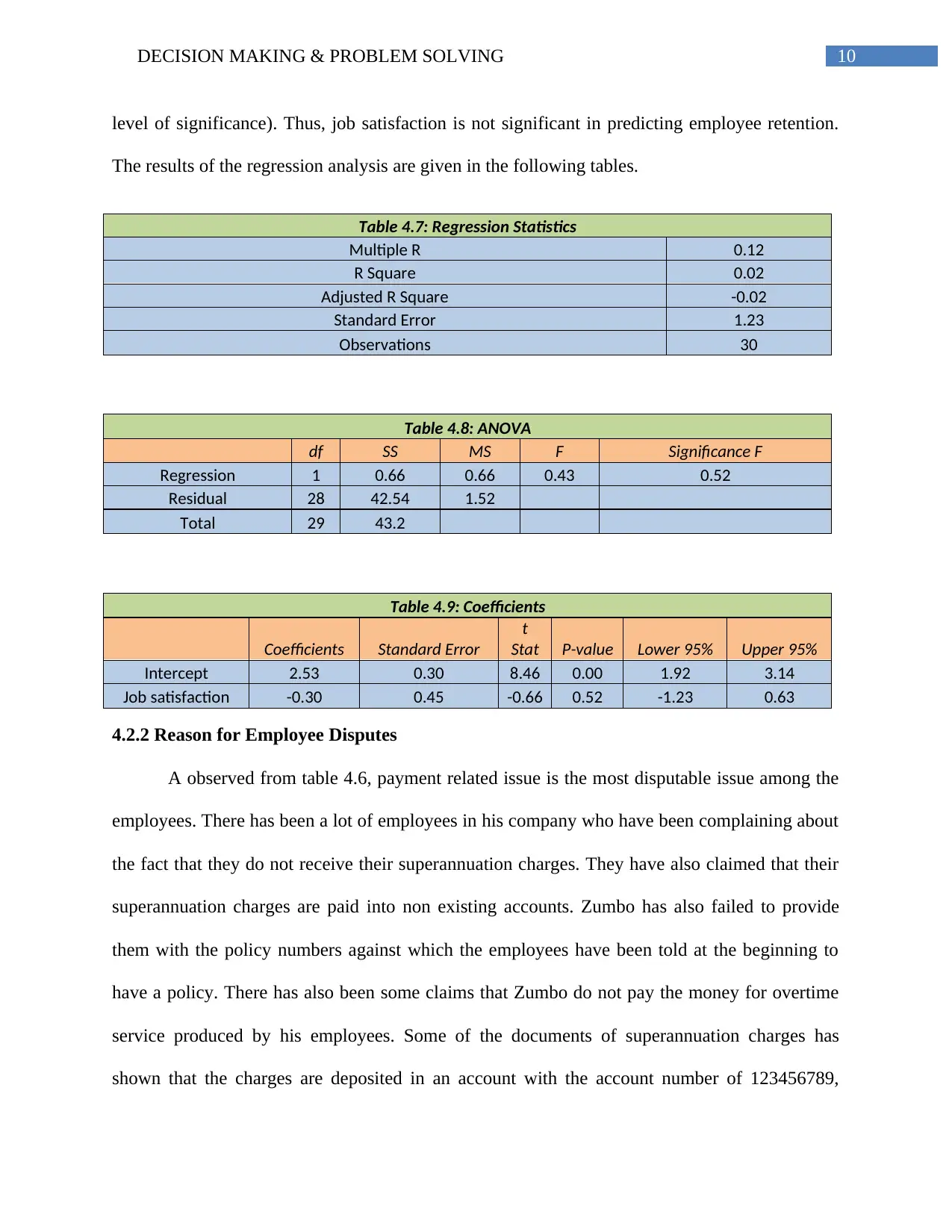
10DECISION MAKING & PROBLEM SOLVING
level of significance). Thus, job satisfaction is not significant in predicting employee retention.
The results of the regression analysis are given in the following tables.
Table 4.7: Regression Statistics
Multiple R 0.12
R Square 0.02
Adjusted R Square -0.02
Standard Error 1.23
Observations 30
Table 4.8: ANOVA
df SS MS F Significance F
Regression 1 0.66 0.66 0.43 0.52
Residual 28 42.54 1.52
Total 29 43.2
Table 4.9: Coefficients
Coefficients Standard Error
t
Stat P-value Lower 95% Upper 95%
Intercept 2.53 0.30 8.46 0.00 1.92 3.14
Job satisfaction -0.30 0.45 -0.66 0.52 -1.23 0.63
4.2.2 Reason for Employee Disputes
A observed from table 4.6, payment related issue is the most disputable issue among the
employees. There has been a lot of employees in his company who have been complaining about
the fact that they do not receive their superannuation charges. They have also claimed that their
superannuation charges are paid into non existing accounts. Zumbo has also failed to provide
them with the policy numbers against which the employees have been told at the beginning to
have a policy. There has also been some claims that Zumbo do not pay the money for overtime
service produced by his employees. Some of the documents of superannuation charges has
shown that the charges are deposited in an account with the account number of 123456789,
level of significance). Thus, job satisfaction is not significant in predicting employee retention.
The results of the regression analysis are given in the following tables.
Table 4.7: Regression Statistics
Multiple R 0.12
R Square 0.02
Adjusted R Square -0.02
Standard Error 1.23
Observations 30
Table 4.8: ANOVA
df SS MS F Significance F
Regression 1 0.66 0.66 0.43 0.52
Residual 28 42.54 1.52
Total 29 43.2
Table 4.9: Coefficients
Coefficients Standard Error
t
Stat P-value Lower 95% Upper 95%
Intercept 2.53 0.30 8.46 0.00 1.92 3.14
Job satisfaction -0.30 0.45 -0.66 0.52 -1.23 0.63
4.2.2 Reason for Employee Disputes
A observed from table 4.6, payment related issue is the most disputable issue among the
employees. There has been a lot of employees in his company who have been complaining about
the fact that they do not receive their superannuation charges. They have also claimed that their
superannuation charges are paid into non existing accounts. Zumbo has also failed to provide
them with the policy numbers against which the employees have been told at the beginning to
have a policy. There has also been some claims that Zumbo do not pay the money for overtime
service produced by his employees. Some of the documents of superannuation charges has
shown that the charges are deposited in an account with the account number of 123456789,
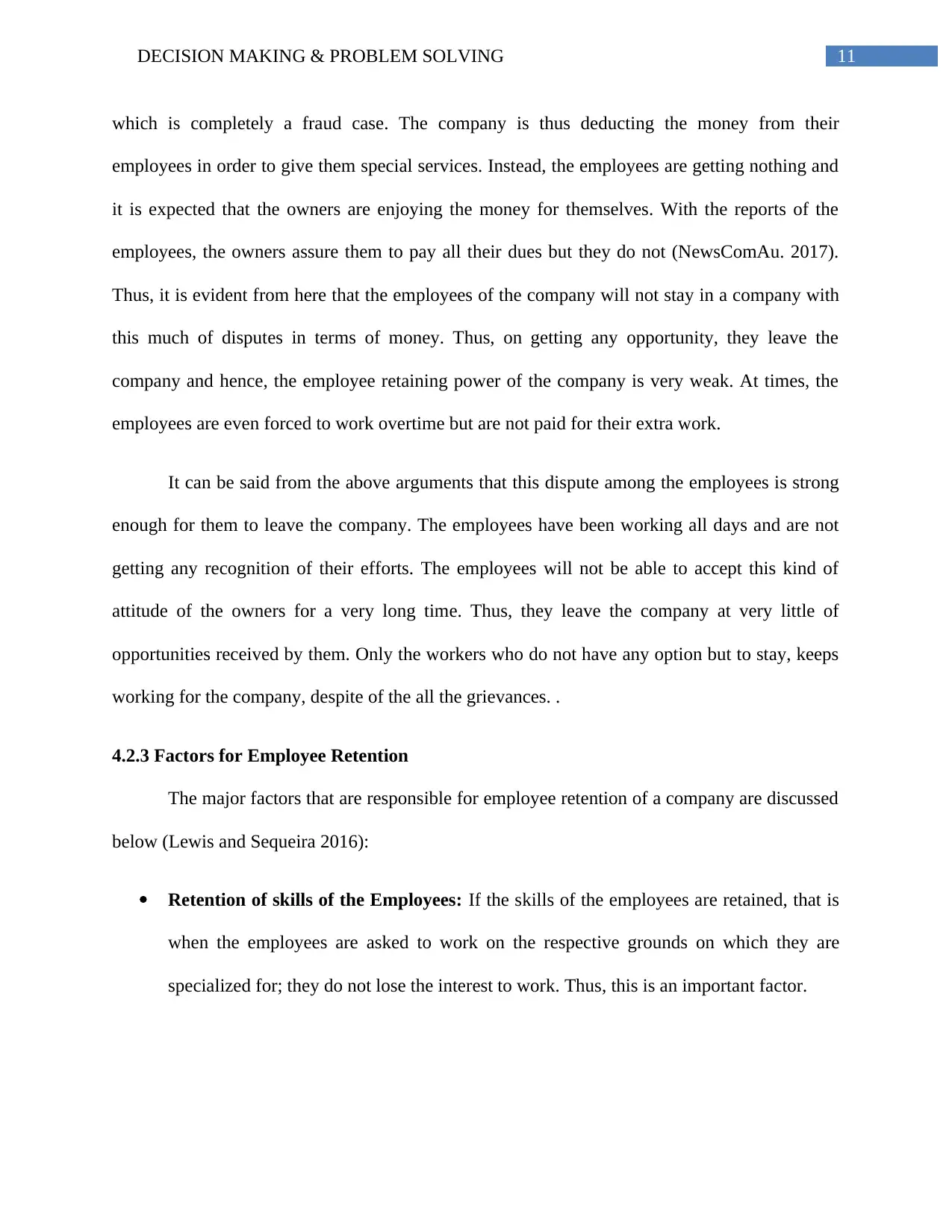
11DECISION MAKING & PROBLEM SOLVING
which is completely a fraud case. The company is thus deducting the money from their
employees in order to give them special services. Instead, the employees are getting nothing and
it is expected that the owners are enjoying the money for themselves. With the reports of the
employees, the owners assure them to pay all their dues but they do not (NewsComAu. 2017).
Thus, it is evident from here that the employees of the company will not stay in a company with
this much of disputes in terms of money. Thus, on getting any opportunity, they leave the
company and hence, the employee retaining power of the company is very weak. At times, the
employees are even forced to work overtime but are not paid for their extra work.
It can be said from the above arguments that this dispute among the employees is strong
enough for them to leave the company. The employees have been working all days and are not
getting any recognition of their efforts. The employees will not be able to accept this kind of
attitude of the owners for a very long time. Thus, they leave the company at very little of
opportunities received by them. Only the workers who do not have any option but to stay, keeps
working for the company, despite of the all the grievances. .
4.2.3 Factors for Employee Retention
The major factors that are responsible for employee retention of a company are discussed
below (Lewis and Sequeira 2016):
Retention of skills of the Employees: If the skills of the employees are retained, that is
when the employees are asked to work on the respective grounds on which they are
specialized for; they do not lose the interest to work. Thus, this is an important factor.
which is completely a fraud case. The company is thus deducting the money from their
employees in order to give them special services. Instead, the employees are getting nothing and
it is expected that the owners are enjoying the money for themselves. With the reports of the
employees, the owners assure them to pay all their dues but they do not (NewsComAu. 2017).
Thus, it is evident from here that the employees of the company will not stay in a company with
this much of disputes in terms of money. Thus, on getting any opportunity, they leave the
company and hence, the employee retaining power of the company is very weak. At times, the
employees are even forced to work overtime but are not paid for their extra work.
It can be said from the above arguments that this dispute among the employees is strong
enough for them to leave the company. The employees have been working all days and are not
getting any recognition of their efforts. The employees will not be able to accept this kind of
attitude of the owners for a very long time. Thus, they leave the company at very little of
opportunities received by them. Only the workers who do not have any option but to stay, keeps
working for the company, despite of the all the grievances. .
4.2.3 Factors for Employee Retention
The major factors that are responsible for employee retention of a company are discussed
below (Lewis and Sequeira 2016):
Retention of skills of the Employees: If the skills of the employees are retained, that is
when the employees are asked to work on the respective grounds on which they are
specialized for; they do not lose the interest to work. Thus, this is an important factor.
⊘ This is a preview!⊘
Do you want full access?
Subscribe today to unlock all pages.

Trusted by 1+ million students worldwide
1 out of 14
Related Documents
Your All-in-One AI-Powered Toolkit for Academic Success.
+13062052269
info@desklib.com
Available 24*7 on WhatsApp / Email
![[object Object]](/_next/static/media/star-bottom.7253800d.svg)
Unlock your academic potential
Copyright © 2020–2026 A2Z Services. All Rights Reserved. Developed and managed by ZUCOL.


